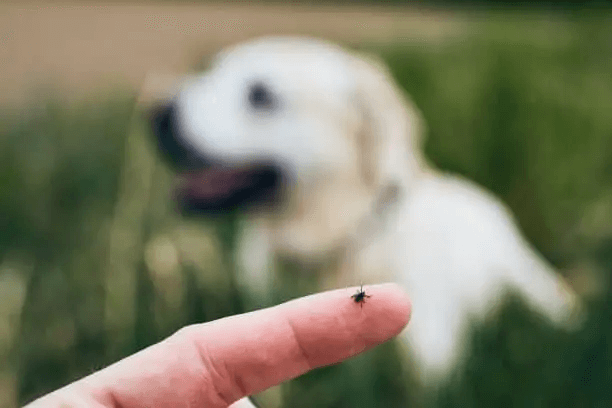
Due to the mild winter this year, experts have predicted that will be higher than ever this year. This blog will tell you everything you need to know about protecting your pets from these tiny but important pests. Here’s your ticks and tick-borne disease resource.
What are Ticks?
Although ticks are commonly thought of as insects, they are (similar to spiders, scorpions, and mites). All ticks have four pairs of legs as adults and have no antennae. By comparison, adult insects have three pairs of legs and one pair of antennae.
Ticks are among the most efficient disease carriers because they firmly attach to hosts when feeding and can often go unnoticed for several days.
What is the Tick’s Life Cycle?
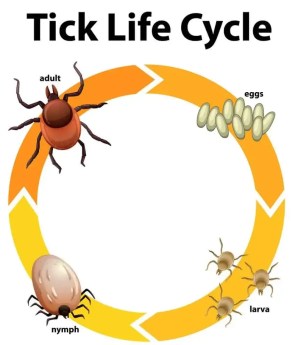
Diagram showing life cycle of tick illustration
To understand ticks and tick-borne disease, you first should learn about the tick’s life cycle.
Ticks are four life stages: egg, larva, nymph, and adult. Females deposit thousands of eggs onto the ground, which then hatch into the larva. The larva, also called a “seed tick,” then feeds on an appropriate host. The larva then develops into the larger nymph, which feeds on a separate host.
Finally, the nymph transforms into an adult. Both male and female adults feed and mate on hosts, and the female finally lays eggs after her feeding. Male hard ticks usually die after mating but may live for several months. The females die soon after depositing eggs onto the ground. The life cycle takes anywhere from 2 months to 2 years, depending on the species of tick. The more warm and humid the environment is, the faster the ticks can complete their life cycle.
What are the Types of Ticks and Tick-Borne Diseases?
There are two groups of ticks- . Hard ticks have a hard shield and are shaped like a flat seed when not engorged. Soft ticks lack the hard shell and are shaped like a large raisin. Soft ticks prefer to feed on birds or bats and are seldom found on dogs or cats.
There are over 15 species of ticks in , however, there are only a few that are likely to be encountered. You can visit for further help with identification.
Deer/Blacklegged Tick
Courtesy of UW-Wisconsin
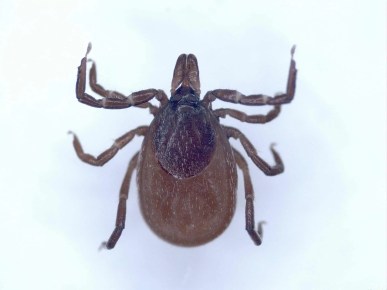
Adult Deer Ticks are reddish-brown and about 1/8-inch long (or about one-half the size of the more familiar female American dog tick). All three active stages of the deer or black-legged tick will feed on various hosts, including dogs and people. After the eggs hatch in the spring, the very tiny larvae feed primarily on white-footed mice or other small mammals.
The following spring, the larvae molt into pinhead-sized, brown nymphs that feed on mice, larger warm-blooded animals, and people. They molt into adults that feed primarily on deer in the fall, with the females laying eggs the following spring.
These ticks are usually found in wooded areas along trails. The larvae and nymphs are active in the spring and early summer; adults may be active in spring and fall. The deer or black-legged tick can transmit Lyme disease and other tick-borne diseases to dogs and humans.
Wood/American Dog Tick

The American dog tick feeds on various hosts, including humans, dogs, and occasionally cats, but rarely infests homes. Adults are chestnut brown with white spots or streaks on their backs. Unfed adults are about 1/8-inch long. Engorged females become slate gray and may expand to a length of 1/2-inch.
Larvae and nymphs feed primarily on small rodents, while adults feed mainly on dogs, cattle, other animals, and humans. These ticks are widely distributed throughout North America and are especially prevalent in the southern United States. The scent of animals attracts them, and humans most often encounter them near paths and recreational areas. Although present year-round, American dog ticks are usually most numerous in the spring.
The female dog tick lays 4000-6500 eggs and then dies. The eggs hatch into seed ticks in about 36-57 days. The unfed larvae crawl in search of a host and can live up to 540 days without food. When they find a small rodent or mammal, the larvae attach and feed for approximately five days. The larvae then drop off the host and molt to the nymphal stage.
The nymphs crawl, searching for a rodent host, attach to a suitable host, and engorge with blood in 3-11 days. Nymphs can live without food for up to 584 days.
Adults crawl in search of dogs or large animals for a blood meal and live for up to two years without food. As an animal passes its location, the tick will grasp it firmly and soon start feeding. The males remain on the host for an indefinite period of time, alternately feeding and mating. The females feed, mate, become engorged and then drop off to lay their eggs. Overall, the American Dog Tick requires three months to 3 years to complete a life cycle.
Lone Star Tick
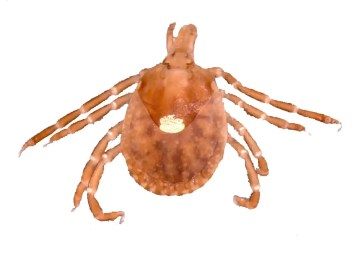
Adult lone star ticks are various shades of brown or tan. Females have single silvery-white spots on their backs, and males have scattered white spots. Unfed adults are about 1/3-inch long, but after feeding, females may be 1/2-inch long. Larvae and nymphs parasitize small wild animals, birds, and rodents, while adults feed on larger animals such as dogs and cattle.
All three stages of the Lone star tick will bite dogs and humans. These ticks live in wooded and brushy areas and are most numerous in the underbrush along creeks and river bottoms near animal resting places. Lone star ticks are present throughout the year, but peak adult and nymphal populations may occur from March to May.
A second nymphal peak may occur again in July or August, while peak larval activity is reached mid-June or July. Lone Star Ticks are most prevalent in the southern United States but are increasing in numbers in the north.
How Did My Dog Get that Tick?
Ticks will wait for host animals on the tips of grasses and shrubs. When brushed by a moving animal/person, they quickly let go and climb onto the host. Ticks cannot fly or jump but can crawl long distances. They can be active on winter days if the temperature is above 45 degrees Fahrenheit.
How do I Remove the Tick?
We do not recommend most methods you read about online because they often cause the ticks to imbed further into your pet or regurgitate potential pathogens into your pet.
The safest and easiest method is to use a tick removal apparatus –we like or products. Always wear gloves when removing a tick, and do not squish them with your bare hands—courtesy of the CDC.
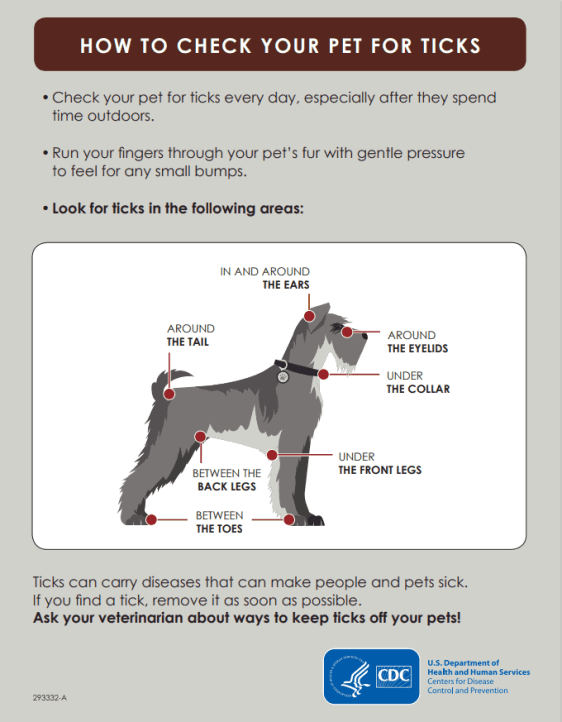
What are the Most Common Diseases that Ticks can Spread?
There are two forms of this condition caused by a bacterial organism. One form affects white blood cells in your pet, but often patients are asymptomatic.
If they do show symptoms, they are vague and flu-like. The other form of anaplasmosis affects your pets’ platelets, causing a mild to severe reduction in the numbers of these essential cells involved in blood clotting. As a result, you can see bleeding of the gums, in the eyes, as well as nosebleeds. The prognosis for both these forms is generally good with proper and prompt treatment.
is caused by a parasite that affects the red blood cells. The immune system attacks the affected red blood cells, causing. Pit bulls are particularly susceptible. Dogs infected with babesiosis may present with a wide variety of clinical signs ranging in severity from sudden collapse to a more slowly progressing infection with no apparent clinical signs.
Typically, clinical signs with the acute form of babesiosis may consist of abnormally dark urine, fever, weakness, pale mucous membranes, depression, swollen lymph nodes, and an enlarged spleen. The prognosis for a dog diagnosed with babesiosis is guarded, and owners should be aware that they often remain sub-clinically infected with babesiosis if they survive.
is also a bacterial infection that affects white blood cells. Signs can be divided into three stages. In the acute (early disease) phase, infected dogs may show fevers, lymph node swelling, respiratory distress, weight loss, bleeding disorders, and occasionally neurological disturbances. They may also be asymptomatic.

The sub-clinical phase is where a dog shows no outward signs of disease. It is often considered the worst phase because it lacks clinical signs; it often goes undetected. Dogs may go on to eliminate the organism, or it may progress to the clinical stage.
The clinical-stage of this is called ehrlichiosis. It occurs when the immune system is not able to eliminate the organism. Dogs are likely to develop various problems: anemia, bleeding episodes, lameness, eye problems, neurological problems, or swollen limbs. A long-term course of antibiotics is required along with supportive measures, but the prognosis is usually good with proper and prompt treatment.
is also caused by a bacterial spirochete. When infection leads to disease in dogs, the dominant clinical sign is recurrent lameness due to joint inflammation. They may also have a decreased appetite and depression. More severe complications of this include kidney damage, and rarely, the heart or nervous system disease. Experimentally, young dogs seem more susceptible to it than older dogs. Following diagnosis, most patients will be treated as an outpatient with a lengthy antibiotic course. Unfortunately, antibiotic treatment does not always eliminate the infection.
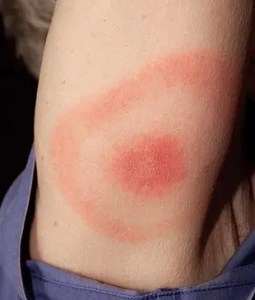
How can I Prevent Tick-Borne Diseases in My Pet?
The best thing to do is to use a flea and tick preventative with your pet. There are topical and oral medications available for dogs and topical options in cats and small mammals. It would be best if you spoke with your veterinarian about which options are best for your pet.
Checking your pet over every time you come in from outside, especially if you’ve been in brush, tall grass, the woods, or by bushes, can help you spot and remove ticks before they have a chance to feed on your pet.
The Veterinarians at Brook-Falls Veterinary Hospital & Exotic Care, Inc. recommends year-round flea and tick preventative.
Ticks can become more active after any warmup, no matter how cold the weather has been. Any temperature over 45 degrees Fahrenheit will cause the ticks to be active.
can also transport ticks and drop them into your yard. Therefore, your pet can be exposed to ticks even in your backyard. Please see your veterinarian to discuss the best options for prevention for your pet and how to best keep them safe from these parasites.
About Brook-Falls
Brook-Falls Veterinary Hospital and Exotic Care is dedicated to providing quality care to all companion pets and exotic animals. Brook-Falls is a Menomonee Falls, WI-based full-service veterinary hospital with an extensive range of comprehensive medical, dental, diagnostic, and surgical services to meet the varying needs of all patients. Brook-Falls Veterinary also offers informational and educational media and seminars for pet owners by way of blogs, digital TV series (Expert Veterinary Television), e-books, whitepapers, infographics, and more.
For more information, contact Brook-Falls Veterinary Hospital & Exotic Care, Inc.


